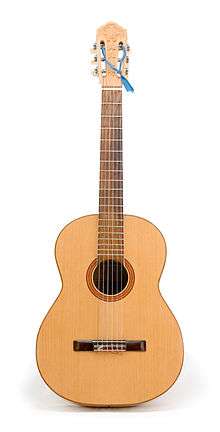Acoustic music
Acoustic music is music that solely or primarily uses instruments that produce sound through acoustic means, as opposed to electric or electronic means. While all music was once acoustic, the retronym "acoustic music" appeared after the advent of electric instruments, such as the electric guitar, electric violin, electric organ and synthesizer.[1] Acoustic string instrumentations had long been a subset of popular music, particularly in folk. It stood in contrast to various other types of music in various eras, including big band music in the pre-rock era, and electric music in the rock era.
| Acoustic music | |
|---|---|
 A Spanish guitar | |
| Stylistic origins | |
| Cultural origins | Ancient |
| Typical instruments | |
| Other topics | |
Music reviewer Craig Conley suggests, "When music is labeled acoustic, unplugged, or unwired, the assumption seems to be that other types of music are cluttered by technology and overproduction and therefore aren't as pure".[2]
Types of acoustic instruments
Acoustic instruments can be split into six groups: string instruments, wind instruments, percussion, other instruments, ensemble instruments, and unclassified instruments.[3] String instruments have a tightly stretched string, that, when set in motion creates energy at (almost) harmonically related frequencies. Wind instruments are in the shape of a pipe and energy is supplied as an air stream into the pipe. Percussion instruments make sound when they are struck, as with a hand or a stick.[4]
History
The original acoustic instrument was the human voice, which produces sound by funneling air across the vocal cords. The first constructed acoustic instrument is believed to be the flute. The oldest surviving flute is as much as 43,000 years old. The flute is believed to have originated in Central Europe.[5] By 1800, the most popular acoustic plucked-string instruments closely resembled the modern day guitar, but with a smaller body. As the century continued, luthier Antonio de Torres Jurado from Spain took these smaller instruments and expanded the bodies to create guitars. Guitar use and popularity grew throughout the 19th century and more acoustic instruments were crafted, such as the double bass. As electric instruments took hold during the 20th century, many stringed instruments were redefined as acoustic. Instruments that involve striking or vibrating the strings, such as the violin, viola and cello, fall under the acoustic category. The violin became popular during the 16th and 17th centuries, due to technological advancements in building them, brought on by luthiers such as Antonio Stradivari and Andrea Amati. The modern version of the instrument developed gradually from older European acoustic stringed instruments such as the lira.
References
- Safire 2007.
- Conley, Craig (August 16, 1999). "Review: Unwired: Acoustic Music from around the World". Splendid. Archived from the original on December 25, 2008. Retrieved November 17, 2008.
- "Instrument List".
- "Acoustic Instruments".
- Iain Morley, "The Evolutionary Origins and Archaeology of Music", PhD diss. (Cambridge: Darwin College, Cambridge University, 2003): 47–48.
Bibliography
- Randel, Don Michael (2003). The Harvard Dictionary of Music. Harvard University Press. ISBN 978-0-674-01163-2.CS1 maint: ref=harv (link)
- Safire, William (2007). "On Language: Retronym". New York Times Magazine (January 7): 18.CS1 maint: ref=harv (link)